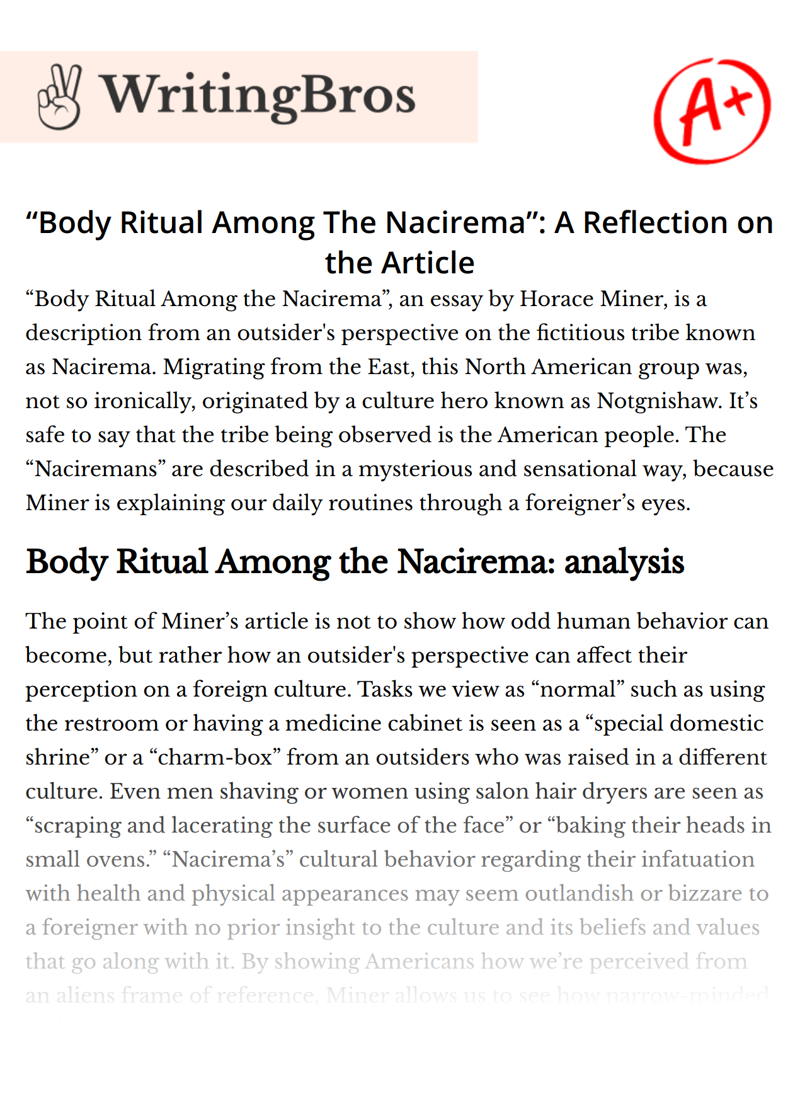“Body Ritual Among The Nacirema”: A Reflection on the Article

Table of contents
- Body Ritual Among the Nacirema: analysis
- Reflection
- References
“Body Ritual Among the Nacirema”, an essay by Horace Miner, is a description from an outsider's perspective on the fictitious tribe known as Nacirema. Migrating from the East, this North American group was, not so ironically, originated by a culture hero known as Notgnishaw. It’s safe to say that the tribe being observed is the American people. The “Naciremans” are described in a mysterious and sensational way, because Miner is explaining our daily routines through a foreigner’s eyes.
Body Ritual Among the Nacirema: analysis
The point of Miner’s article is not to show how odd human behavior can become, but rather how an outsider's perspective can affect their perception on a foreign culture. Tasks we view as “normal” such as using the restroom or having a medicine cabinet is seen as a “special domestic shrine” or a “charm-box” from an outsiders who was raised in a different culture. Even men shaving or women using salon hair dryers are seen as “scraping and lacerating the surface of the face” or “baking their heads in small ovens.”
“Nacirema’s” cultural behavior regarding their infatuation with health and physical appearances may seem outlandish or bizzare to a foreigner with no prior insight to the culture and its beliefs and values that go along with it. By showing Americans how we’re perceived from an aliens frame of reference, Miner allows us to see how narrow-minded and faulty our representations can be of other cultures. Without taking the holistic perspective into consideration with any society, cultural misunderstandings could occur.
Miner's point of "Body Ritual Among the Nacirema" is validation that no matter the culture or the people immersed in that culture, they’ll always seem abnormal or bizarre to us because they have customs we’re not familiar with. However, that being said, when looking within our own culture and customs, we validate and justify even the oddest behavior and rituals.
This article is important because it highlights the problem of representation in ethnography. After reading this article, one wonders how is it possible to be an outsider and observe another culture without a biased opinion or how is it possible to understand our own culture within. Either way, there’s always going to be somebody who doesn’t understand enough or understands too much to the point where they cannot shape their opinion. Which leads me to cultural relativism, where to properly evaluate one's culture and understand it they have to be native to that culture, and any other third party trying to analyse the culture simply can not put their own biases aside to interpret it. If we always look at things from the outside in we can see obvious tendencies and cultures. On the flip side one could easily miss the deeper meaning in normal interactions around them. It was not until after reading Miner’s article and noticing Notgnishaw spelled backwards is Washington that his presidency wasn’t the only thing he was famous for, he was also famous for cutting down a cherry tree and crossing the Potomac (Pa-To-Mac) River.
Reflection
Not only did I get a quick history lesson, but I also realized when Miner refers to “limiting intercourse to certain phases of the moon”, he’s referring to the use of birth control which I had no idea was centered around the phases of the moon. Miner’s article and the folktale “The Blind Men and the Elephant” are very similar in the way that the perception from the narrators in both tales believed their opinions to be accurate based on their personal experiences, however they were both limited from the truth by not being open minded and considering that their knowledge may be incomplete. As for Miner’s article, the narrator saw “small bundle of hog hairs and certain magical powders” or “highly formalized series of gestures” when in reality it was just brushing our teeth with a toothbrush and toothpaste to those of us who live inside this culture. Similar to the blind men, they saw a wall, snake, spear, cow, carpet or rope when in reality it was just a small part of something bigger, an elephant. These stories have several ideas, themes and lessons attached to them such as the necessity for cultural diffusion in order to get a larger perspective on life, as well as seeking out participant observation to learn about the cultures around them and the importance of having a holistic perspective in order to understand a person, culture or even an animal as having a biased, close minded, preconceived idea can be dire misinterpreted perspectives of a culture.
The idea of culture to me is a system of shared beliefs, rituals, concepts, and values that allow a community to peacefully interact and communicate that can reflect and transmit to follow generations to continue. If I were a cultural anthropologist, I would no doubt use the participant observation method and submerge myself into the society to try to understand and appreciate the morals values whatever culture it is I’m observing. Being the independent and strong minded person I am I think it may be difficult for me to close off my preconceived ideas and notions, however I think if I mentally put myself into this culture I’d no doubt.
References
- Miner, H. (1956). Body ritual among the Nacirema. American Anthropologist, 58(3), 503-507. doi: 10.1525/aa.1956.58.3.02a00080
- Kilson, M. (1967). "Body Ritual among the Nacirema": A Note on the Author. American Anthropologist, 69(2), 203-205. doi: 10.1525/aa.1967.69.2.02a00130
- Swartz, M. J. (1990). Culture & power: The sociology of Pierre Bourdieu. University of Chicago Press.
- Emmerichs, M. R. (1973). Role theory and “Body Ritual among the Nacirema”. Teaching Sociology, 1(2), 138-142. doi: 10.2307/1316908
- Aho, J. A. (1994). The Body in Postmodern Anthropology. Body & Society, 1(2), 1-23. doi: 10.1177/1357034X94001002001
Cite this Essay
To export a reference to this article please select a referencing style below

